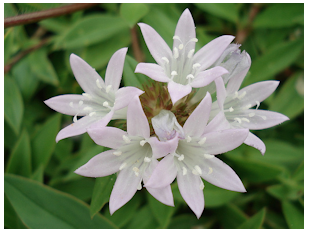Controlling Weeds
 I have a special place in my heart (and garden) for some of the perennials that most would call weeds. Since I am an avid butterfly gardener as well, I am careful to look up each plant before proclaiming that they all be stamped out and destroyed. Many tiny flowered 'weeds' actually provide nectar, and in some cases, are actual larval food sources for their caterpillars.
I have a special place in my heart (and garden) for some of the perennials that most would call weeds. Since I am an avid butterfly gardener as well, I am careful to look up each plant before proclaiming that they all be stamped out and destroyed. Many tiny flowered 'weeds' actually provide nectar, and in some cases, are actual larval food sources for their caterpillars.
For that reason, I also almost never use products like Roundup and other weed killers, to rid my lawn of annual, biennial and perennial weeds. Organic control is the way I go. With all of these things in mind, I will share of few methods I do incorporate into my gardening practices to be rid of plants that I consider stickers, and weeds.
In essence, my lawn is a mixture of grasses and various benefical flowering perennials and annuals. If I do pull anything up, it is a sticker of some kind, or I am preparing a bed for vegetable gardening.
I can often be found pulling weeds by hand. This is a surefire way to get rid of them, especially if you get the taproot that many of them pocess. If you can get to them before they flower, you will essentially be getting rid of a lot more weeds, by only removing the mother plant. Try wetting the ground thoroughly, or waiting until after a good soaking rain, to pull them. It loosens the ground and makes them easier to pull.
Annual weeds can easily be killed by cutting them off at ground level. You will not have to pull the roots, they will rot in the earth. If you can do this before they flower, you will have gotten rid of them for the season, and lots of their children. Keeping up with this every spring will begin to thin them out, until most will disappear.
Perennial weeds are the worst weeds to try and control. Because they can reproduce themselves by bulbs, runners, and deep underground roots that snap into pieces when you pull them, they are much more persistant.
If you are trying to prepare a plot for veggie gardening, do not use a rototiller to break loose the soil. Instead, dig with a shovel, overturning it enough to have the roots of the weeds fall off of the soil. In this way you can remove them in full pieces. The rototiller would simply break the roots into many pieces, and within weeks you would have 4 times as many weeds!
A simpler method that takes a lot less time and effort is using thick black plastic or plastic tarp to smother them out. The drawback is that this method will take a year to eliminate the weeds. Weight it down, and wait for the following spring. Remove the tarp, and hand dig out any remaining roots as you turn the soil with a shovel.
If you are a person who reads the newspaper, begin saving them up and laying them out in the intended plot area. This will not only smother the weeds off, but the newspaper will also break down into the soil. This method also takes about a year to work.
Make sure to place all weed remains onto the compost pile. Be sure it heats up and breaks down properly so that no seeds remain viable.
You can also use the tarp method to plant a lazy man's garden. Spread it out after enriching the surface soil with some good compost. Then stake the tarp out in the corners to hold it down. Poke holes through the tarp at the proper path and patch intervals and plant out your seedling vegetable crops. Make sure to water through the same hole, so that your food crop does not wither. The plastic will help keep the soil warm and boost the crop. This is a great method for those in the higher states. Here in Florida it may be too intense if you try it in summer. But winter is the right time to veggie garden in Florida, so give it a try then if you can't deal with the intensive labor hand pulling incurs.
Tags: controlling weeds, organically control weeds,,organic weed control, quackgrass, canadian thistle, weeds, pulling weeds, poison ivy, bindweed,


